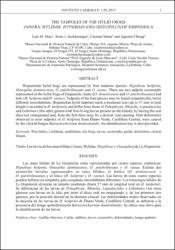Mostrar el registro sencillo del ítem
The tadpoles of the hylid frogs (Anura: Hylidae: Hypsiboas and Osteopilus) of Hispaniola
| Licencia | Creative Commons Atribución-NoComercial 4.0. | es |
| Autor | Díaz, Luis M. | |
| Autor | Incháustegui, Sixto J. | |
| Autor | Marte, Christian | |
| Autor | Chong, Agustín | |
| Fecha de admisión | 2024-04-02T22:19:18Z | |
| Fecha disponible | 2024-04-02T22:19:18Z | |
| Año | 2015 | |
| Citación | Díaz, L. M., Incháustegui, S. J., Marte, C., & Chong, A. (2015). The tadpoles of the hylid frogs (Anura: Hylidae: Hypsiboas and Osteopilus) of Hispaniola. Novitates Caribaea, (8), 1–29. Recuperado de: | es |
| URI | https://bvearmb.do/handle/123456789/4310 | |
| Sinopsis | Abstract: Hispaniolan hylid frogs are represented by four endemic species: Hypsiboas heilprini, Osteopilus dominicensis, O. pulchrilineatus and O. vastus. There are two tadpole ecomorphs represented in the hylid frogs of Hispaniola: lentic (O. dominicensis and O. pulchrilineatus) and lotic (H. heilprini and O. vastus). Tadpoles of the four species may be found sympatrically, but in different microhabitats. Hispaniolan hylid tadpoles reach a moderate size (up to 57 mm in total length is recorded in H. heilprini), and differ from those of Peltophryne, Rhinella, Leptodactylus and Lithobates (the other genera with free-living larvae present on the island), by having the oral discs not emarginated and, from the first three taxa, by a dextral vent opening. Oral deformities observed in most tadpoles of H. heilprini from Ébano Verde, Cordillera Central, were caused by the chytrid fungus Batrachochytrium dendrobatidis. An identification key is also provided. | es |
| Sinopsis | Resumen: Las ranas hílidas de la Hispaniola están representadas por cuatro especies endémicas: Hypsiboas heilprini, Osteopilus dominicensis, O. pulchrilineatus y O. vastus. Existen dosecomorfos larvales representados en estos hílidos: el léntico (O. dominicensis y O. pulchrilineatus) y el lótico (H. heilprini y O. vastus). Las larvas de estas cuatro especies pueden hallarse en simpatría, pero ocupando microhábitats diferentes. Los renacuajos hílidos de La Hispaniola alcanzan un tamaño moderado (hasta 57 mm de longitud total en H. heilprini). Se diferencian de las larvas de Peltophryne, Rhinella, Leptodactylus y Lithobates (los otros géneros con larvas en la isla) por tener el disco oral no emarginado y, de los primeros tres géneros, por la posición dextral de la abertura cloacal. Las deformidades orales observadas en la mayoría de las larvas de H. heilprini de Ébano Verde, Cordillera Central, se debieron a la presencia del hongo quitridiomiceto Batrachochytrium dendrobatidis. Se ofrece una clave para la identificación de las larvas. | es |
| Idioma | English | es |
| Publicado | Novitates Caribaea, (8), 1–29 | es |
| Derechos | © Museo Nacional de Historia Natural “Prof. Eugenio de Jesús Marcano”. Todos los derechos reservados. | es |
| URI de derechos | https://creativecommons.org/licenses/by-nc/4.0/ | es |
| Materia | Biodiversidad - República Dominicana | es |
| Materia | Fauna ─ República Dominicana | es |
| Materia | Hábitats y especies | es |
| Título | The tadpoles of the hylid frogs (Anura: Hylidae: Hypsiboas and Osteopilus) of Hispaniola | es |
| dc.identifier.doi | https://doi.org/10.33800/nc.v0i8.39 | |
| Tipo de material | Article | es |
| Tipo de contenido | Scientific research | es |
| Acceso | Open | es |
| Audiencia | Technicians, professionals and scientists | es |
Ficheros en el ítem
Este ítem aparece en la(s) siguiente(s) colección(es)
-
Investigación ambiental [1698]


